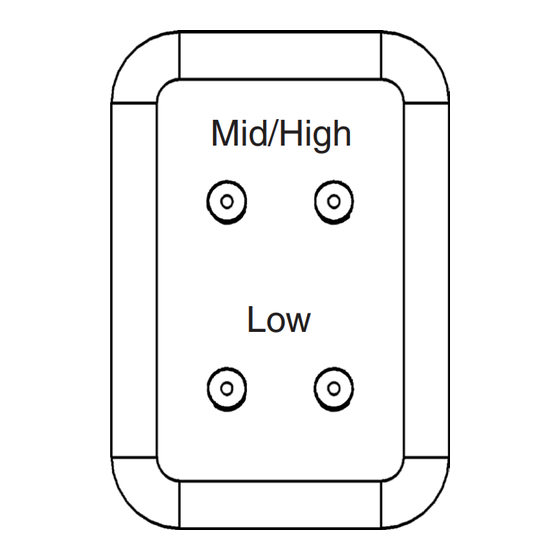
Advertisement
Quick Links
Danley TDH3 Loudspeaker Startup Guide
Unpacking & Inspection
Remove the loudspeaker carefully from the packaging and check
for any signs of damage incurred during transit. If there are signs of
damage, contact your shipper immediately.
Positioning
Place the TDH3 Loudspeaker in the desired position. Ensure it's
on a flat, stable surface. Further details on positioning are on the
reverse of this document
Connecting
At the back of the speaker, locate the binding post terminals.
Unscrew the top part of the terminals slightly to open up the binding
post.
Terminals are designed to accept stripped bare wire ends,
4mm banana plugs, or spade terminals. Avoid using crimps on bare
wire ends, as these may lead to weak link bar connections.
If using bare wires: Insert the wire into the space between the
binding post and the screw cap. Make sure the wire is firmly held
when the cap is tightened. Ensure that no stray strands of wire are
sticking out, which could cause a short circuit.
If using banana plugs: Simply insert the banana plug into the hole in
the middle of the binding post.
Be careful to connect the positive and negative terminals on each
connection panel to their matching positive and negative terminals
on your amplifier. Misconnections can cause a lack of bass output
and a broad, unstable stereo image, indicative of out-of-polarity
loudspeakers. If your system displays these symptoms, double-
check the wiring polarity.
Settings
The amplifier selection significantly impacts the TDH3 Loudspeaker's
performance. Here are a few points to consider:
The TDH3's extended low-frequency response implies relatively low
sensitivity, a common trade-off with passive loudspeakers. For best
performance, consider amplifiers offering over 400W power output
into 8 ohms.
Use of an underpowered amplifier can result in system distortion
and increased risk of damage from voice coil overheating.
Safety
Never exceed the loudspeaker's power rating. Regularly check cables for damage and replace if necessary. Keep the loudspeaker dry and away
from moisture to prevent damage.
NOTE: This guide assumes the user has a basic understanding of audio setup and safety precautions. Always refer to the user manual provided
by the manufacturer for a more detailed setup and safety instructions. If you are uncertain or uncomfortable with any step, consult a professional
audio technician.
Danley Sound Labs Inc.
Understanding the Connection Panel
The TDH3 Loudspeaker features a "bi-wire" connection panel
allowing distinct amplification of the bass and mid/high driver. Refer
to drawing below for the connection panel's diagram.
For standard wiring, your speaker cable can be connected to either
the top or bottom pair of horizontal terminals. If you want to use the
bi-wire feature, remove the bridging bars between the vertical pairs
of terminals. The upper horizontal pair is for the mid/high while the
lower pair connects to the bass driver.
Selecting Speaker Cable
Choose high-quality speaker cables with a minimum 12 AWG/2mm.
If your cable runs exceed 15ft/5m, opt for a heavier gauge cable. 10
AWG/2.5mm will suffice for cable runs under 100ft/30m.
Bi-Wire
Mid/High
Low
DO NOT connect two amp channels with the bridging bar in place.
1
Standard Wire
Full Range
Rev. 20230725
danleysoundlabs.com | 877.419.5805
Advertisement

Summary of Contents for Danley TDH3
- Page 1 For standard wiring, your speaker cable can be connected to either the top or bottom pair of horizontal terminals. If you want to use the Place the TDH3 Loudspeaker in the desired position. Ensure it’s bi-wire feature, remove the bridging bars between the vertical pairs on a flat, stable surface.
- Page 2 Rev. 20230725 danleysoundlabs.com | 877.419.5805 Danley Sound Labs Inc.
Need help?
Do you have a question about the TDH3 and is the answer not in the manual?
Questions and answers